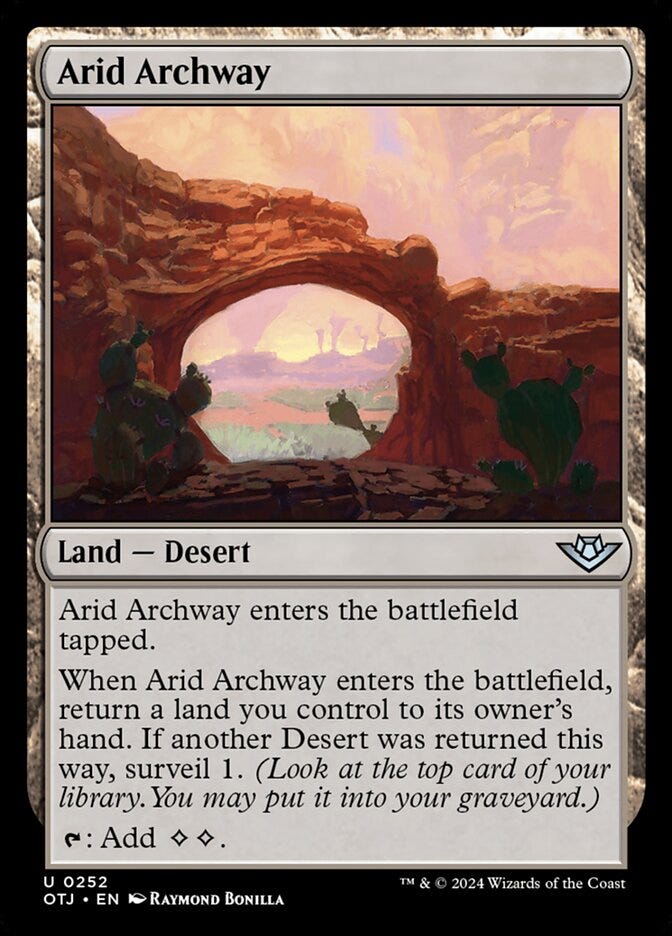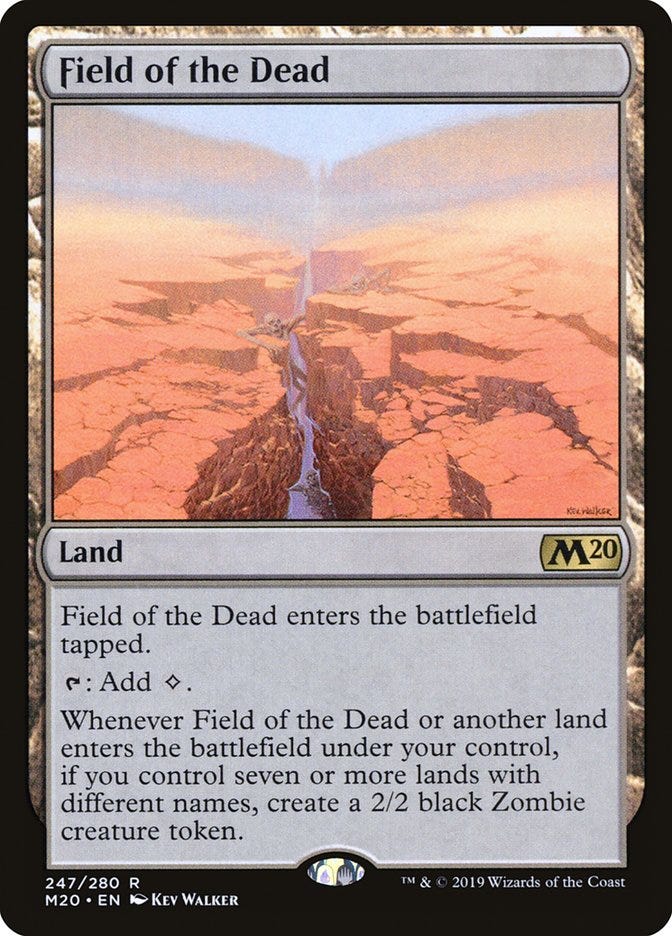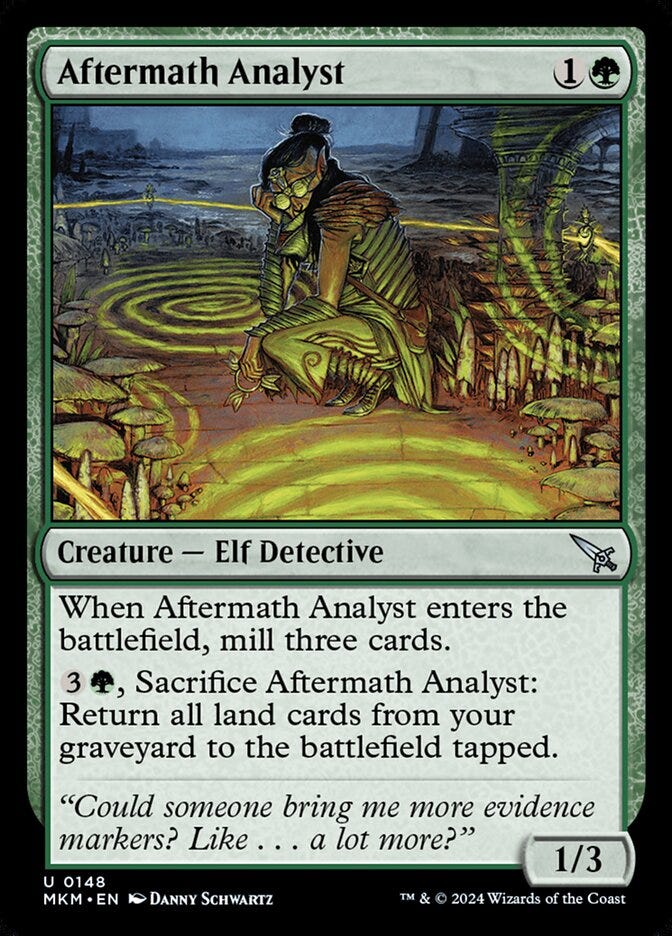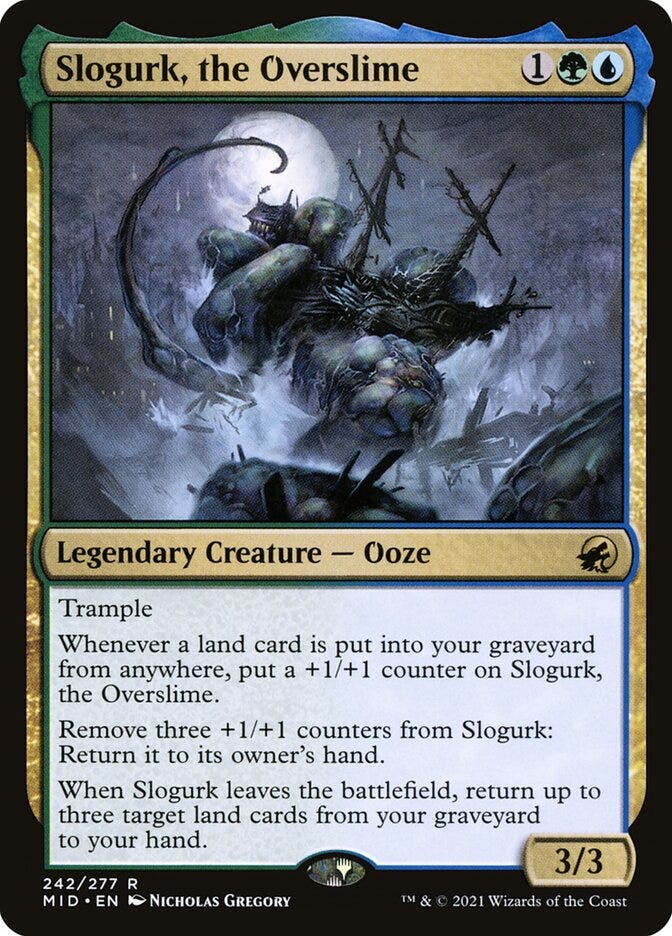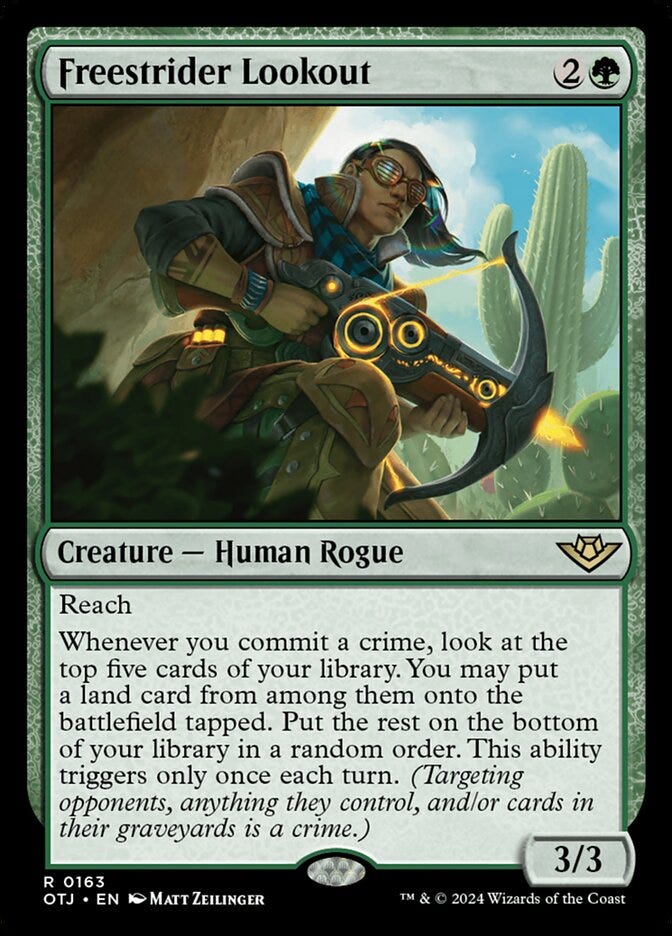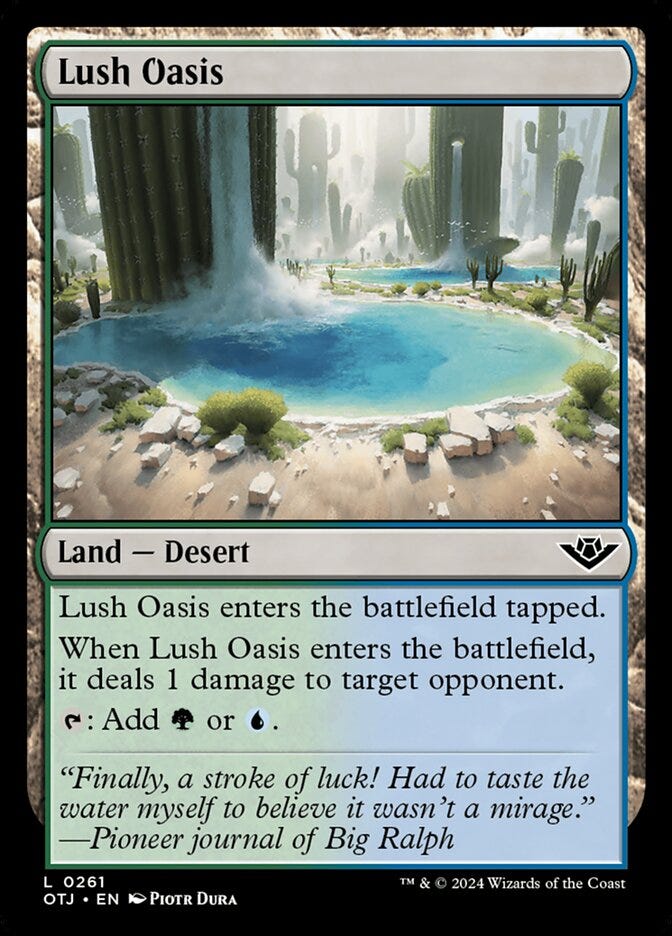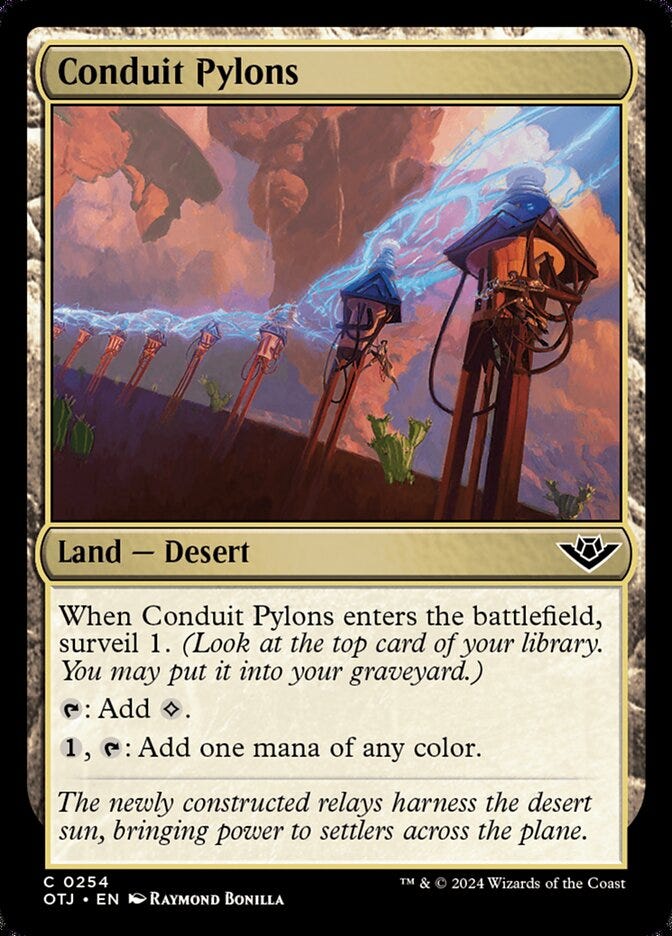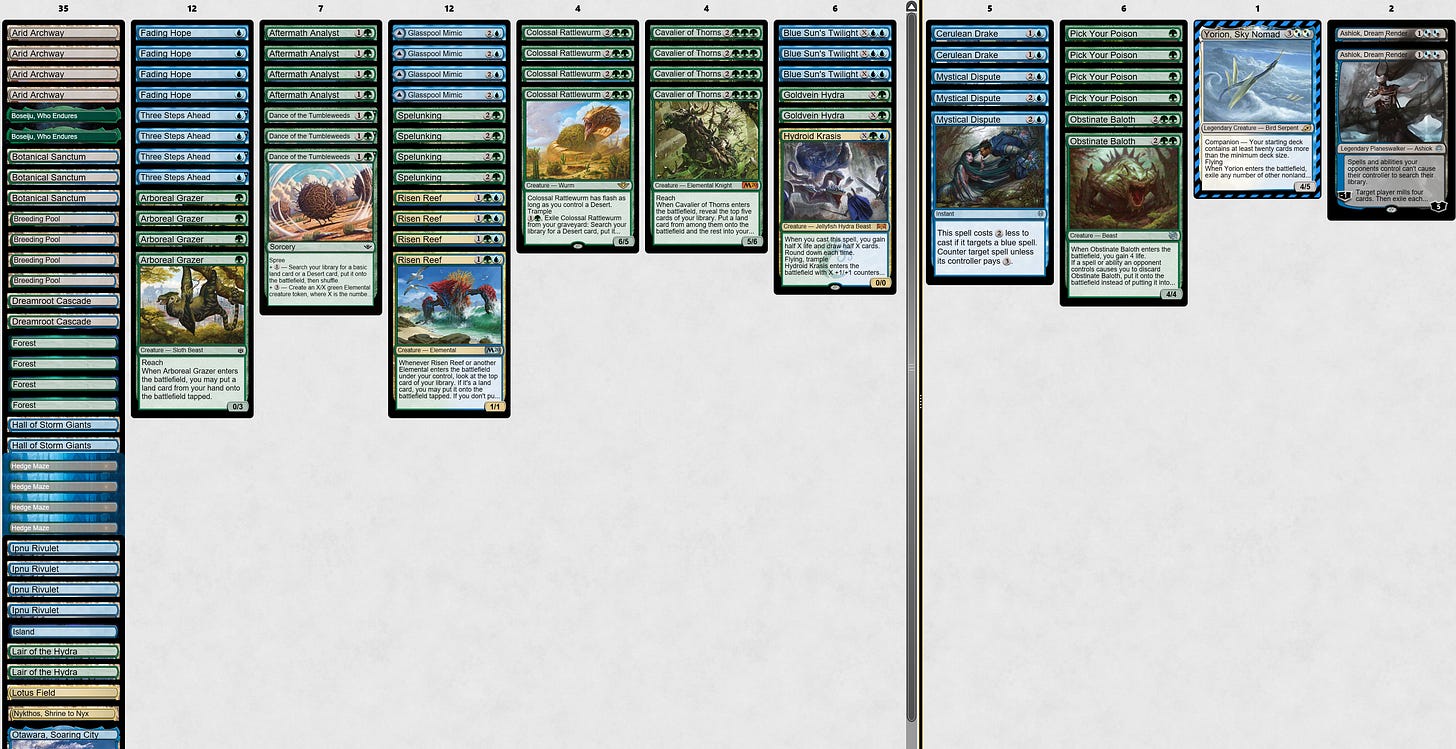I have been brewing and testing a bunch of Simic Desert decks recently. I have had some good results, but haven’t cracked it yet. In this articles I'll lay out where I see the strengths in Deserts, some thoughts on how to think about the role of lands in your Pioneer brews, and end with a bunch of decklists I’ve tested.
Why Deserts?
If you read my Simic Elementals article it is evident I have become a bit obsessed with Arid Archway.
It is a land that essentially draws you a land when it enters the battlefield. That is serious value if you can build around its constraints. It has even further upside of enabling a Surveil if you are running other Deserts. Getting a free Surveil is meaningful value which started me on this Desert road.
There is another Desert out there that has even higher upside potential and where most of my recent Desert brewing has been focused:
What card do you think of when you see Ipnu Rivulet? The card I think of is:
On one level this likely seems like a crazy comparison. Field of the Dead is one of the most powerful cards ever printed and is banned in Pioneer as well as higher power formats like Modern and Historic.
The thing that makes Field of the Dead so strong is it gives your deck inevitability from the land slot. This both frees up the rest of your deck to not worry about wincons and lands are notoriously difficult to interact with so it is true inevitability.
Ipnu Rivulet provides that inevitability as well. Admittedly it is worse inevitability, but it’s better as a land, being untapped and providing colored mana. And now it provides broader Desert synergy.
And it’s a more reasonable comparison when you realize, there was a period where Ipnu Rivulet was one of the best cards in Pioneer. Even with cards like Teferi, Time Reveler, Underworld Breach, and Uro being legal, Ipnu Rivulet was so well positioned it was still a top card.
Specifically, this was during the heyday of Dimir Inverter, Ipnu Rivulet provided a perfect counter to the combo, that you could run maindeck in a blue deck at essentially no cost (the damage from Rivulet hurt in some matchups, but it also acted as a wincon against UW control so it was a wash).
I talk about the deck I was running then in this article. My Inverter matchup was 50/50 or 60/40 at best and then I replaced 4 Islands with Rivulets and the matchup immediately shifted to 90+% winrate.
Inverter was around 20% of the meta, so adding the Rivulets took my deck from around a 70% winrate to something close to an 80% winrate. That is an outrageous impact for one card to have, but that’s what happens when you get to add lands that can operate like spells to your deck because you essentially get the spell for free.
Ipnu Rivulet Synergies
There are a few recent cards that provide exciting Synergy with Ipnu Rivulet.
Standard All-Star (and likely critically underexplored in Pioneer) Aftermath Analyst synergizes amazingly with Rivulet.
At the end of your opponents turn hold up Three Steps Ahead, if they do nothing Sacrifice Rivulet targeting yourself, to get 2-3 additional lands in your yard, and then activate Analyst for an overwhelming mana advantage.
Analyst also becomes the key to the mill wincon: sacrifice a bunch of Deserts to your Rivulets milling your opponent, then activate Analyst to run it all back. Here’s a match where I milled out a Yorion Niv to Light deck, by sacrificing 9 Deserts to Rivulet across three turns for a total of 36 cards. They were able to remove all my non-land permanents but couldn’t stop Rivulet.
Another Standard All Star that works great with Rivulet is Slogurk:
Rivulet provides instant speed 2 or 3 counters on Gurk. And then gets pulled back to your hand if you return Gurk to your hand, so you can just run it back again creating some real inevitability.
If you are going for the mill out with a bunch of Deserts plan (remember you can sacrifice other Deserts to Rivulet), you want to get most of the lands in your deck onto the battlefield and the new Freestrider Lookout is the best card around for that.
This was a card I started testing because it was featured on Faithless Brewing. Despite playing with it a fair amount I am still unsure if it is good. Sometimes it can totally take over the game…and sometimes it’s a 3/3 for three which is bad. It’s also unclear how much you want to build around being able to commit crimes every turn vs rely on more incidental crimes and hoping for a few triggers being enough.
With Freestrider for Deserts specifically it works great with the ping Deserts like Lush Oasis as a crime trigger.
Other Desert Synergies
Rattlewurm pairs well with all of the Three Steps Ahead decks I have been running. It can allow you to hold up a proactive flash threat to pair with the reactive Three Steps, much like how UW control has the Wandering Emperor to pair with counterspells.
But the reason I really like Colossal Rattlewurm is because it is so good against Liliana. Discard it to Liliana, then activate to find Arid Archway. Suddenly instead of going down a card you ramped and have the same number of cards in hand. So a lot of how much I want to run Rattlewurm will depend on how popular Mono-B is.
I think I am the only person playing this card, but it can feel kind of insane at times. If you are really going for Deserts it will often be a 3 mana 5/6, draw 2 (Arid Archway), surveil 2 (Arid Archway returning Conduit Pylons). The biggest thing holding it back is the lack of trample so you need a bit more for it to be your wincon.
I still haven’t figured out what to make of Conduit Pylons, but there is a chance it is great and we are sleeping on it. Think about how much better Consider is than Opt and especially how much better Consider is than a vanilla card draw. Here we get a free surveil on an untapped land with a relevant card type. I suspect in general all the Surveil lands are being underutilized and we will see interactive decks slowly adding more and more to their manabases.
Lands in Pioneer
If Modern is defined by its free spells, I would say Pioneer is defined by leveraging your lands to do more than add a mana a turn. This can be either providing multiple mana or providing a spell like effect (which includes turning into a creature).
Essentially, since it is hard to “cheat” on mana in Pioneer, you need to find and maximize other spots to “cheat” on resources and one of those is to get “free” card draw when you are able to leverage your lands for a spell like effect. This makes sense, a land that can act as a spell late game is similar to a Companion and we all know how strong Companions are.
If we look at top decks you have:
Rakdos Vampires- The quiet thing that makes Vampires so much better than Rakdos Midrange is it very effectively runs 4 Mutavaults as opposed to Rakdos Midranges zero Mutavaults (in most versions)
Mono-Black Waste Not- 4 Castle Locthwain, 4 Field of Ruin, 3 Geier Reach, 2 Hive, this a deck that solely exists because of the power of the lands it gets to run. Just the combo of Waste Not and Geier Reach provides inevitability
UW Control is similar to Mono-Black with a huge collection of utility and creature lands
Lotus and Mono-Green Devotion are obvious examples of leveraging lands that get you multiple lands worth of mana out of one land. (It is the same rationale for why I have been working on so many Arid Archway decks)
Mono-Red Aggro- Of my losses against Mono-Red it feels a third are to Ramunap Ruins
Phoenix- Less obvious here, but the card I quietly struggle the most to deal with is Hall of the Storm Giants. The Temporal Trespass combo in particular is strong because it maximizes the power of Hall.
It’s not all decks: none of Niv to Light, Amalia, or Gruul Slickshot are focused on maximizing their lands as spells, but most decks are.
What does this mean for us brewers? You should be asking yourself “how is my deck using its lands to win the game?” (beyond their normal function of providing one mana a turn) If you can’t answer that question it should be a warning sign for your brew.
An implication of this is you should be focused on playing one or two color decks where you have more land slots to work with because you do not need to use so many on fixing.
The importance of lands that do something beyond the traditional land role of providing a mana turn is why I have been so focused on these Desert decks because it is an unexplored area where there are clear patterns for how your lands will win you the game.
Simic Desert Lists
These decks have been difficult to crack, so I’ve got a bunch of lists. I’ll share a few representative ones with some commentary.
Simic Desert Yorion Elementals
This is where I started with Deserts. Adding more of a Desert theme to the Simic Elementals list I discuss here. You get the nice Rattlewurm and Three Steps Ahead synergies and the Ipnu Rivulet + Aftermath Analyst + Phyrexian Jace alternative wincon.
This decks was good and I got a trophy with it and went 5-2 in a challenge. But the format has sped up, since then and the deck has felt less well positioned.
This version was bad and made me realize Dance of the Tumbleweeds was a step too far on the Desert synergy front (but it makes an elemental so had to give a try with Risen Reef!)
Simic Desert Slogurk
I liked some of the ideas here. Main plan is attacking with big creatures, while having a backup mill plan and some good velocity. The curve needs some work, but felt promising and was fun to play (I had a number of people ask me for the list while playing this one).
Here was another version, that was not good.
I was surprised how much worse the Fallaji Archaeologists were than the Aftermath Analysts. This was a learning lesson for me: what makes the Analysts good is they represent a threat to the opponent and will frequently be removed. Archaeologist is always ignored when it is on the battlefield, so even though it creates card advantage immediately, Analyst actually creates more tempo advantage.
Simic Desert Crab Crimes
I have no idea how I got a 4-1 with this. The Ruin Crabs and Armored Scrapgorgers were bad. I think this is a reflection that the rest of the core is strong, so I have been trying to figure out what to do with those 8 slots.
Simic Desert Crimes
This list was good, not great. Duelist of the Mind has nice synergies with Slogurk and Rattlewurm. Overall 4 Slogurk was probably too much. I also worry about how much upside the deck has because it felt a bit like a classic 1-2/2-1 deck where it can have strong sequences where it comfortably wins, but can struggle on the draw or if the cards come out of sequence.
Simic Desert Fae of Wishes
This is on my to test lists. Trying to be a bit less synergy and more good size creature and then rely on Fae of Wishes for help going over the top.
Bant Yorion Landfall Deserts
The idea here was to leverage Broker’s hideout, Slogurk, and Nissa, Resurgent Animist. The deck was kind of miserable to play and the mana is so bad for casting all the Triple-G spells, but the results weren’t awful, so maybe there’s something here. At face value this looks like it has less desert synergy, but the deck was actually really dependent on Rivulet for winning either by pumping Gurk or milling out the opponent.
The move might be to cut Cavalier and Storm for 4-color Omnath, but need to cut Arid Archway at that point and that is a broader rethink of the deck.
Temur Desert Crimes
Ok this list is absurd with 12 of the ping Deserts. I thought it would be terrible but it was stuck in my head, so I had to play it.
It wasn’t great, but was definitely ok and one I could see coming back to. Doing 5+ damage from your lands over the course of the game is nothing to sneeze at and the Outcaster Greenblades were huge. Also, Magda + Goldvein Hydra is fun and reasonably powerful and I want to eventually find a home for it.
Pioneer Deserts
I have been having ok to good results with these lists with several 4-1s, but no trophies. It has not been all good and there have definitely been a few losing leagues in there as well.
I think the Simic Desert Yorion Elementals list continues to be strong, particularly if the format is slowing down and it is more of a Niv and Mono-B driven meta.
I am really not sure how to feel about Slogurk, sometimes it takes over the game but a lot of the times it feels like it is asking too much for what these lists can enable. So in my recent lists I have not been including Slogurk and have been focusing more on Outcaster Greenblade as the large three drop.
Then the other big question is “how serious do you want to be about milling them out plan?”. When you run Jace Perfected Mind along with the Rivulets it becomes a very legitimate threat that is tough for a lot of decks to deal with, but you need to figure out how to win against decks with reasonably sized creatures and a good curve. I think some of my problem is I am a bit too balanced and I would be better off leaning stronger in one of the damage direction or in the mill direction.
Let me know if you try out any of these decks or have your own Desert list. I think there is something here, but there are so many possibilities of how to approach the deck that it will take awhile to find the best lists.



